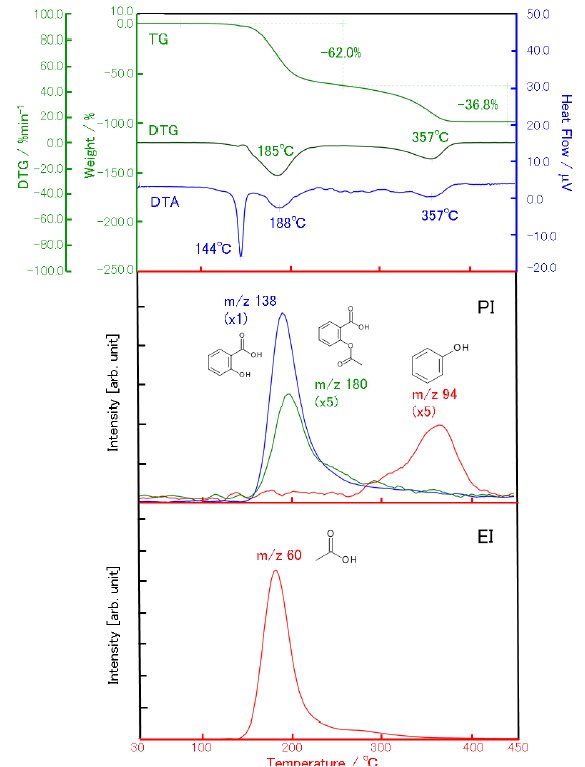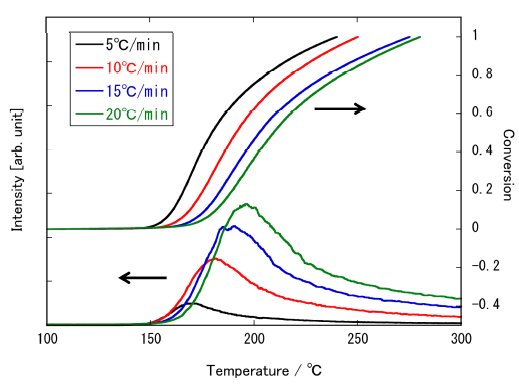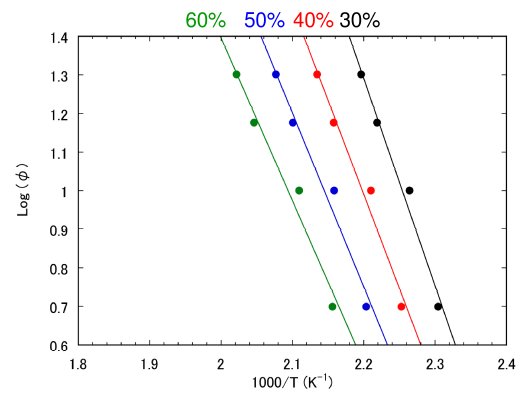Evolved Gas and Kinetic Analysis of Acetylsalicylic Acid
Introduction
Thermogravimetry-Mass spectrometry (TG-MS) is a crucial analytical system for the investigation of ther-mal decomposition, H₂O contents, and reaction process under the certain temperature.
In this investigation, we detected the evolved gases from acetylsalicylic acid upon heating by Thermo Mass Photo. Furthermore, we estimated the activation energy and the reaction time.
Instrument: Thermo Mass Photo
Thermo Mass Photo is a versatile measurement system of thermogravimetry-differential thermal analysis (TG-DTA) and photoionization mass spectrometry
(PIMS). In this system, weight change, endothermic or exothermic phenomena, and evolved gases can be analyzed simultaneously. Therefore, Thermo Mass Photo is considered a promising analytical tool for fundamental research, qualification control, and development of new materials.
Thermo Mass Photo has a unique interface, called skimmer type interface, which transfers evolved gases efficiently. We can select Photoionization (PI) as well as Electron ionization (EI) on the mass spectrometer. The combination of PI and EI enables us to identify the gases easily.
Experimental
Acetylsalicylic acid was loaded into Al pans with 4 mg, and heated at 20 ºC/min under He atmosphere. Their reactions were monitored by TG, DTA, and MS in Thermo Mass Photo.
This measurement was repeated with change in the heating rates of 5, 10, 15, and 20°C/min to evaluate the kinetic analysis.
Results and Discussion
Upon heating of acetylsalicylic acid under inert at-mosphere of He, two-step weight losses were ob-served in Figure 1.
In the temperature range of the first weight loss (120-250 ºC), we observed two endothermic peaks at 144 and 188ºC in the DTA curve. In addition, we detected the ions for salicylic acid, acetylsalicylic acid, and acetic acid In MS. The endothermic peak at 144ºC is attributed to the fusion of acetylsalicylic acid.
The peak at 188ºC is considered due to the sublimation or evaporation of acetylsalicylic acid and the thermal decomposition, which generates salicylic acid and acetic acid.
In the temperature range of the second weight loss (250-400ºC), we observed the endothermic peak at 357ºC in DTA and the ion for phenol in MS. Phenol is generated by the thermal decomposition.
The curve-shape of the thermal analysis dependent of the heating conditions reflects the kinetics of the reaction. This information has been widely utilized for estimation of reactivity and stability of materials, such as lifetime. Generally, TG curves have been applied to the kinetic analysis. However, TG curves are not appropriate if the multiple reactions occur in the same temperature range such as the first weight loss in this measurement. We recommend that the thermal pro-files of evolved gases are applied to the kinetic analysis of the multiple reactions. This analysis provides the specified information on the reaction products.
The activation energy of the reaction for the generation of salicylic acid was calculated from the MS ion ther-mogram of the m/z 138 ion in PI, corresponding to the molecular ion of salicylic acid. Figure 2 shows the MS ion thermogram of m/z 138 with changing of the heat-ing rates. In addition, the reaction rate derived from the integration of the signal intensity is also shown in Figure 2. The reaction rate allows us to form the Flynn-Wall-Ozawa plots as shown in Figure 3. The activation energy was 89 kJmol⁻¹ at the reaction rate of 40% where the generation of salicylic acid becomes maximum. We can estimate the reaction time of 6849 hours (285 days) required for this reaction rate at 25ºC.

Figure 1: TG-DTA profile and MS ion thermogram of acetylsalicylic acid.

Figure 2: MS ion thermogram of m/z 138 (PI) and its conversion profile.

Figure 3: Flynn-Wall-Ozawa plots for generation of salicylic acid.

Contact Us
Whether you're interested in getting a quote, want a demo, need technical support, or simply have a question, we're here to help.
